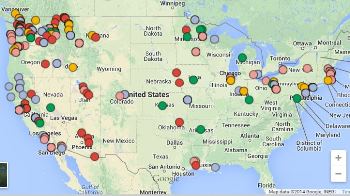Founded in 1905, the Industrial Workers of the World captured the imagination of a generation with its fiery rhetoric, daring tactics, and program of revolutionary industrial unionism. Pledging to replace the narrow craft unionism of the American Federal of Labor with massive industrial unions, the IWW's revolutionary goals and commitment to anarcho-syndicalism positioned it to the left of the Socialist Party as well as the AFL.
In the years leading up to World War I, the organization grew in numbers and reputation, demonstrating an ability to organize workers neglected by the AFL, notably immigrant steel and textile workers in the Northeast, miners, timber and agricultural workers in the West.
But the IWW's revolutionary program and class-war rhetoric yielded more enemies than allies. Frequently harrassed, jailed, or beaten when they tried to organize, the Wobblies faced something far more serious after the United States mobilized for war in 1917. Over the next several years, federal and state goverments moved to suppress the organization, imprisoning hundreds of Wobblies, passing criminal syndicalism laws that made membership a crime. The IWW survived and is active today, but never regained the momentum of its early years.
This project explores the history of the IWW in its first two decades. We have compiled a database of hundreds of strikes, campaigns, arrests, and other incidents involving IWW members and present this information in both yearbook format and in elaborate interactive maps. Here you will also find accounts of important events and a wealth of primary sources, including pages from the Industrial Worker, the IWW monthly published in Spokane and Seattle.
Co-directed by Professor James Gregory and Labor Archivist Conor Casey, the project utilizes the resources of the Labor Archives of Washington State and University of Washington Libraries. Research Associates: Arianne Hermida, Rebecca Flores, Cameron Molyneux
Start exploring the IWW History project with our Storymap/timeline that illustrates and briefly describes critical events from the founding of the IWW in 1905 through the difficulties of the mid 1920s. 
Timeline/History

Maps of IWW activities
Our pages of interactive maps locate more than 1800 strikes, campaigns, arrests involving the IWW between 1905 and 1924.
These yearbooks provide the most complete account of IWW events -- a day-by-day database of hundreds of strikes, protests, campaigns, and labor political initiatives as recorded in the pages of the Industrial Worker.
Articles about important events, issues, and people including:cr500.jpg)
Essays/articles
Scores of digital images from the Labor Archives, University of Washington Libraries.
So far we have identified 928 union locals, branches, and District Councils in more than 350 cities and towns in 38 states and territories of the United States and 5 Canadian provinces. These maps and tables detail the ninety known American periodicals officially affiliated with the Industrial Workers of the World in the early decades of the 20th century (excluding single-issue publications). They were published in 19 different languages and, although many were short-lived and claimed tiny circulations, key newspapers lasted into the 1930s, and the Industrial Worker continues today. We have developed maps, lists, and charts detailing more than 300 incidents in which IWW members were subjected to arrests, trials, assaults, vigilante actions, and other violence. We have developed maps, lists, and charts detailing nearly 400 strike actions led or supported by the IWW, as recorded in the Industrial Worker, Solidarity, Industrial Union Bulletin, and several non IWW newspapers. It was perhaps the deadliest day in the turbulent history of the IWW. At least five Wobblies (and perhaps as many as twelve) died along with two deputies on the afternoon of November 5, 1916 when Sheriff McRea and 200 armed and hastilly deputized men met the steamer Verona at the Everett dock. A short list of key sources. This site is part of the Civil Rights and Labor History Consortium based at the University of Washington under the direction of Professor James Gregory.
IWW Locals
IWW Newspapers

Raids, Arrests, Violence
Strikes

Everett Massacre
Bibliography & links
About the project